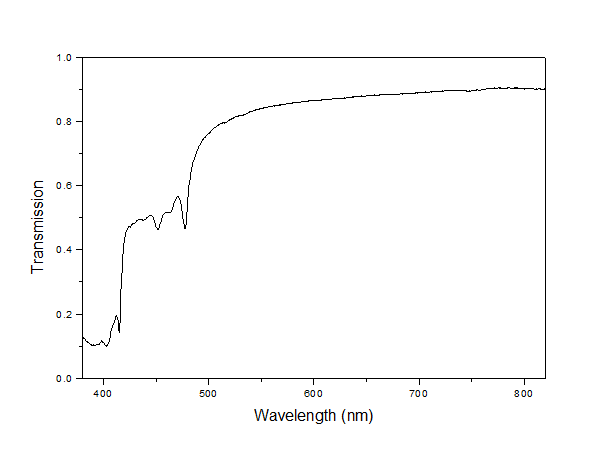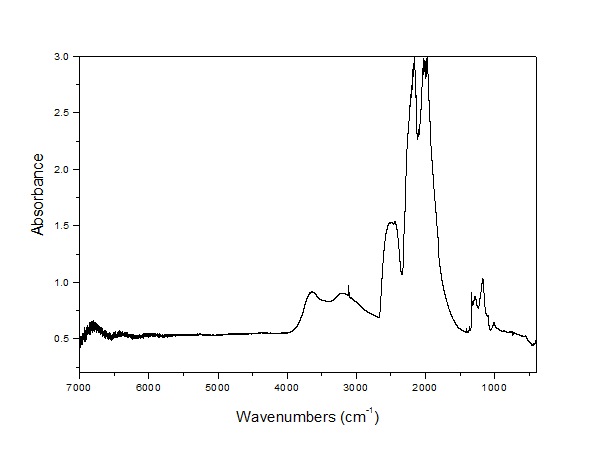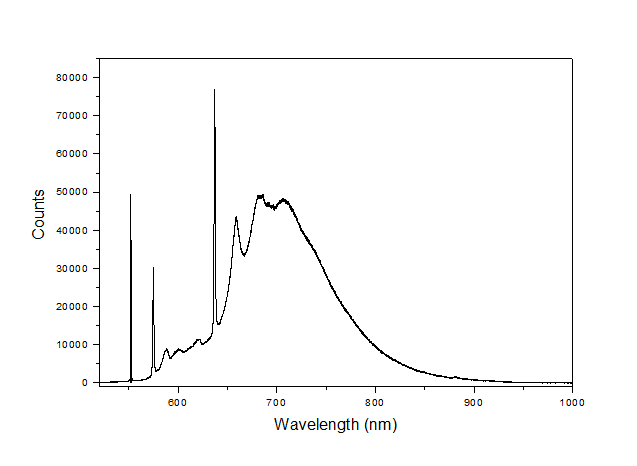
Spectroscopy
Spectroscopy in all his colors
The spectroscopic equipment is shared with HRD Antwerp Research
 In UV-Vis spectroscopy ultraviolet and visible light illuminates a stone and the absorption of certain colours is analysed.
In principle, the UV-Vis absorption spectrum is the scientific representation of the diamond’s color. Furthermore, the absorption
graph gives indications whether a diamond has been heat treated or irradiated.
A UV-Vis spectrum can represent absorption or transmission values (refer to the description of the axes)
plotted versus the color (wavelength). A maximum in the absorption spectrum indicates the colors that are
absorbed more than the other colors. A maximum in the transmission spectrum indicates the colors that are
less absorbed than the others, and hence give rise to the color perceived by our eyes.
In UV-Vis spectroscopy ultraviolet and visible light illuminates a stone and the absorption of certain colours is analysed.
In principle, the UV-Vis absorption spectrum is the scientific representation of the diamond’s color. Furthermore, the absorption
graph gives indications whether a diamond has been heat treated or irradiated.
A UV-Vis spectrum can represent absorption or transmission values (refer to the description of the axes)
plotted versus the color (wavelength). A maximum in the absorption spectrum indicates the colors that are
absorbed more than the other colors. A maximum in the transmission spectrum indicates the colors that are
less absorbed than the others, and hence give rise to the color perceived by our eyes.
 Fourier Transform Infra Red spectroscopy studies the absorption of infrared light.
A Fourier Transform is a mathematical technique used to facilitate the experimental setup.
The infrared absorption spectrum contains a part unique to diamonds and another part related
to the impurities (mostly nitrogen) in the diamond. FT-IR spectroscopy therefore not only proves
whether it’s a diamond or not, but also reveals the diamond type.
Fourier Transform Infra Red spectroscopy studies the absorption of infrared light.
A Fourier Transform is a mathematical technique used to facilitate the experimental setup.
The infrared absorption spectrum contains a part unique to diamonds and another part related
to the impurities (mostly nitrogen) in the diamond. FT-IR spectroscopy therefore not only proves
whether it’s a diamond or not, but also reveals the diamond type.
 Photoluminescence spectroscopy is not an absorption technique in which a wide range of colors are
illumination the sample to determine the relative absorption (or transmission) of these different colors.
Instead, light of a single color is used (monochromatic light), emitted by a laser. This laser light generates
light of another color, similar to the bluish fluorescence of some diamonds under a UV-lamp. The colours generated
and their relative intensities provide detailed knowledge about the defects and impurities in the diamond.
Photoluminescence spectra are important for the detection of treated as well as of synthetic diamonds.
Photoluminescence spectroscopy is not an absorption technique in which a wide range of colors are
illumination the sample to determine the relative absorption (or transmission) of these different colors.
Instead, light of a single color is used (monochromatic light), emitted by a laser. This laser light generates
light of another color, similar to the bluish fluorescence of some diamonds under a UV-lamp. The colours generated
and their relative intensities provide detailed knowledge about the defects and impurities in the diamond.
Photoluminescence spectra are important for the detection of treated as well as of synthetic diamonds.
Optical spectroscopy
Optical spectroscopy is the preferred technique for the characterization of diamonds and gemstones
because of its non-destructive nature. Optical spectroscopy illuminates a diamond with light in the optical part of the spectrum
and analyses the light after interaction with the diamond. The optical part of the electromagnetic spectrum ranges from ultraviolet
light (UV) over the visible part (the colours of the rainbow) into the infrared light (IR). Different kinds of interaction of this
incoming light with a diamond are possible. Part of the light may be absorbed and this effect is used in UV-Vis and FT-IR spectroscopy.
Alternatively, the incoming light can create light with a different colour (or wavelength), so-called fluorescence or photoluminescence.
Many natural diamonds have a more or less pronounced fluorescence, mostly of a blue colour. The absorption and luminescence of diamonds
provide key knowledge about the atomic defects present in the diamond, and is very important for detecting treated as well as synthetic diamonds.
UV-Vis spectroscopy
 In UV-Vis spectroscopy ultraviolet and visible light illuminates a stone and the absorption of certain colours is analysed.
In principle, the UV-Vis absorption spectrum is the scientific representation of the diamond’s color. Furthermore, the absorption
graph gives indications whether a diamond has been heat treated or irradiated.
A UV-Vis spectrum can represent absorption or transmission values (refer to the description of the axes)
plotted versus the color (wavelength). A maximum in the absorption spectrum indicates the colors that are
absorbed more than the other colors. A maximum in the transmission spectrum indicates the colors that are
less absorbed than the others, and hence give rise to the color perceived by our eyes.
In UV-Vis spectroscopy ultraviolet and visible light illuminates a stone and the absorption of certain colours is analysed.
In principle, the UV-Vis absorption spectrum is the scientific representation of the diamond’s color. Furthermore, the absorption
graph gives indications whether a diamond has been heat treated or irradiated.
A UV-Vis spectrum can represent absorption or transmission values (refer to the description of the axes)
plotted versus the color (wavelength). A maximum in the absorption spectrum indicates the colors that are
absorbed more than the other colors. A maximum in the transmission spectrum indicates the colors that are
less absorbed than the others, and hence give rise to the color perceived by our eyes.
FT-IR spectroscopy
 Fourier Transform Infra Red spectroscopy studies the absorption of infrared light.
A Fourier Transform is a mathematical technique used to facilitate the experimental setup.
The infrared absorption spectrum contains a part unique to diamonds and another part related
to the impurities (mostly nitrogen) in the diamond. FT-IR spectroscopy therefore not only proves
whether it’s a diamond or not, but also reveals the diamond type.
Fourier Transform Infra Red spectroscopy studies the absorption of infrared light.
A Fourier Transform is a mathematical technique used to facilitate the experimental setup.
The infrared absorption spectrum contains a part unique to diamonds and another part related
to the impurities (mostly nitrogen) in the diamond. FT-IR spectroscopy therefore not only proves
whether it’s a diamond or not, but also reveals the diamond type.
Raman / Photoluminescence spectroscopy
 Photoluminescence spectroscopy is not an absorption technique in which a wide range of colors are
illumination the sample to determine the relative absorption (or transmission) of these different colors.
Instead, light of a single color is used (monochromatic light), emitted by a laser. This laser light generates
light of another color, similar to the bluish fluorescence of some diamonds under a UV-lamp. The colours generated
and their relative intensities provide detailed knowledge about the defects and impurities in the diamond.
Photoluminescence spectra are important for the detection of treated as well as of synthetic diamonds.
Photoluminescence spectroscopy is not an absorption technique in which a wide range of colors are
illumination the sample to determine the relative absorption (or transmission) of these different colors.
Instead, light of a single color is used (monochromatic light), emitted by a laser. This laser light generates
light of another color, similar to the bluish fluorescence of some diamonds under a UV-lamp. The colours generated
and their relative intensities provide detailed knowledge about the defects and impurities in the diamond.
Photoluminescence spectra are important for the detection of treated as well as of synthetic diamonds.
Contact
Technical advisor Ing. Guy van Goethem, WTOCD